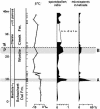Environmental mutagenesis during the end-Permian ecological crisis
- PMID: 15282373
- PMCID: PMC516500
- DOI: 10.1073/pnas.0404472101
Environmental mutagenesis during the end-Permian ecological crisis
Abstract
During the end-Permian ecological crisis, terrestrial ecosystems experienced preferential dieback of woody vegetation. Across the world, surviving herbaceous lycopsids played a pioneering role in repopulating deforested terrain. We document that the microspores of these lycopsids were regularly released in unseparated tetrads indicative of failure to complete the normal process of spore development. Although involvement of mutation has long been hinted at or proposed in theory, this finding provides concrete evidence for chronic environmental mutagenesis at the time of global ecological crisis. Prolonged exposure to enhanced UV radiation could account satisfactorily for a worldwide increase in land plant mutation. At the end of the Permian, a period of raised UV stress may have been the consequence of severe disruption of the stratospheric ozone balance by excessive emission of hydrothermal organohalogens in the vast area of Siberian Traps volcanism.
Copyright 2004 The National Academy of Sciencs of the USA
Figures



Comment in
-
The complexity of mass extinction.Proc Natl Acad Sci U S A. 2004 Aug 31;101(35):12779-80. doi: 10.1073/pnas.0404933101. Epub 2004 Aug 24. Proc Natl Acad Sci U S A. 2004. PMID: 15328409 Free PMC article. No abstract available.
Similar articles
-
UV-B-induced forest sterility: Implications of ozone shield failure in Earth's largest extinction.Sci Adv. 2018 Feb 7;4(2):e1700618. doi: 10.1126/sciadv.1700618. eCollection 2018 Feb. Sci Adv. 2018. PMID: 29441357 Free PMC article.
-
The stability of the stratospheric ozone layer during the end-Permian eruption of the Siberian Traps.Philos Trans A Math Phys Eng Sci. 2007 Jul 15;365(1856):1843-66. doi: 10.1098/rsta.2007.2046. Philos Trans A Math Phys Eng Sci. 2007. PMID: 17513258
-
The role of UV-B radiation in aquatic and terrestrial ecosystems--an experimental and functional analysis of the evolution of UV-absorbing compounds.J Photochem Photobiol B. 2002 Feb;66(1):2-12. doi: 10.1016/s1011-1344(01)00269-x. J Photochem Photobiol B. 2002. PMID: 11849977
-
Depletion of stratospheric ozone over the Antarctic and Arctic: responses of plants of polar terrestrial ecosystems to enhanced UV-B, an overview.Environ Pollut. 2005 Oct;137(3):428-42. doi: 10.1016/j.envpol.2005.01.048. Epub 2005 Apr 21. Environ Pollut. 2005. PMID: 16005756 Review.
-
Terrestrial ecosystems, increased solar ultraviolet radiation, and interactions with other climate change factors.Photochem Photobiol Sci. 2007 Mar;6(3):252-66. doi: 10.1039/b700019g. Epub 2007 Feb 1. Photochem Photobiol Sci. 2007. PMID: 17344961 Review.
Cited by
-
The terrestrial end-Permian mass extinction in the paleotropics postdates the marine extinction.Sci Adv. 2024 Feb 2;10(5):eadi7284. doi: 10.1126/sciadv.adi7284. Epub 2024 Jan 31. Sci Adv. 2024. PMID: 38295161 Free PMC article.
-
Light controls growth and development via a conserved pathway in the fungal kingdom.PLoS Biol. 2005 Apr;3(4):e95. doi: 10.1371/journal.pbio.0030095. Epub 2005 Mar 15. PLoS Biol. 2005. PMID: 15760278 Free PMC article.
-
Aberrant Classopollis pollen reveals evidence for unreduced (2n) pollen in the conifer family Cheirolepidiaceae during the Triassic-Jurassic transition.Proc Biol Sci. 2013 Aug 7;280(1768):20131708. doi: 10.1098/rspb.2013.1708. Print 2013 Oct 7. Proc Biol Sci. 2013. PMID: 23926159 Free PMC article.
-
The evolutionary significance of polyploidy.Nat Rev Genet. 2017 Jul;18(7):411-424. doi: 10.1038/nrg.2017.26. Epub 2017 May 15. Nat Rev Genet. 2017. PMID: 28502977 Review.
-
Widespread ancient whole-genome duplications in Malpighiales coincide with Eocene global climatic upheaval.New Phytol. 2019 Jan;221(1):565-576. doi: 10.1111/nph.15357. Epub 2018 Jul 21. New Phytol. 2019. PMID: 30030969 Free PMC article.
References
-
- Erwin, D. H. (1993) The Great Paleozoic Crisis (Columbia Univ. Press, New York).
-
- Alpen, E. L. (1998) Radiation Biophysics (Academic, New York), 2nd Ed.
-
- Taylor, G. E., Jr., Pitelka, L. F. & Clegg, M. T., eds. (1991) Ecological Genetics and Air Pollution (Springer-Verlag, Berlin).
Publication types
MeSH terms
Substances
LinkOut - more resources
Full Text Sources

